Fencing of a terrace made of wood is very popular: from boards, slats, logs and beams.
- First, this material is cheaper.
- Secondly, it is easy to process.
- Thirdly, it does not provide for wet works.
- Fourth, it has tremendous artistic potential.
The only point where the board loses to brick or concrete is durability. But you are not planning to build a family castle, but a terrace? And therefore, the declared five to fifteen years behind a tree will be quite enough for you.
But let's talk better about design. After all, all these letters, not letters, will not be worth the time spent on their writing, if you do not like wooden fences for the terrace.
Cross to cross
A simple and effective type of wooden palisades, which, in addition to being a barrier and decorative one, also performs a structural function, acting as slanting, for a canopy located on the terrace.
As a starting material, a timber connected to a half-tree is used, moreover, it is used for slanting, and for railings, and for vertical supports. Although stone structures can also act as the latter.
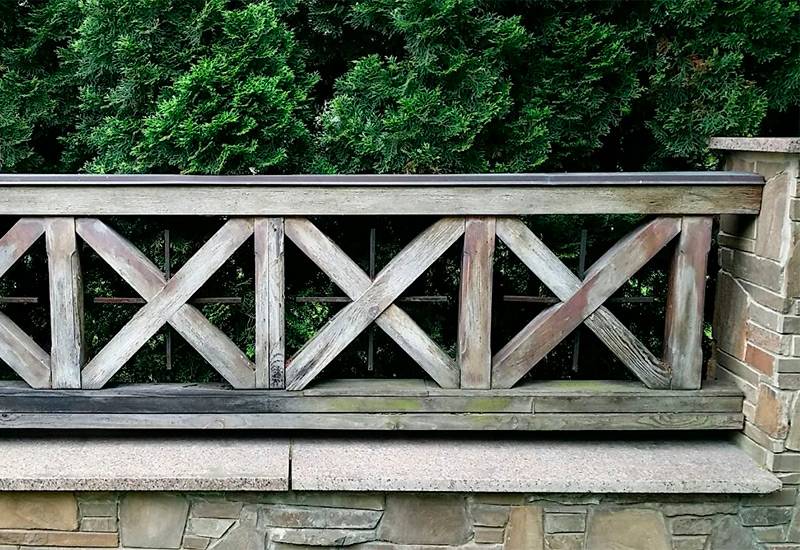

Ranch
Another simple, but equally beautiful type of wooden railing is the ranch-style fence. It consists of supports and horizontal bars or boards. It does not differ in particular rigidity, but it looks solid and presentable. In the twenty-first century, there is a steady trend towards simple solutions.

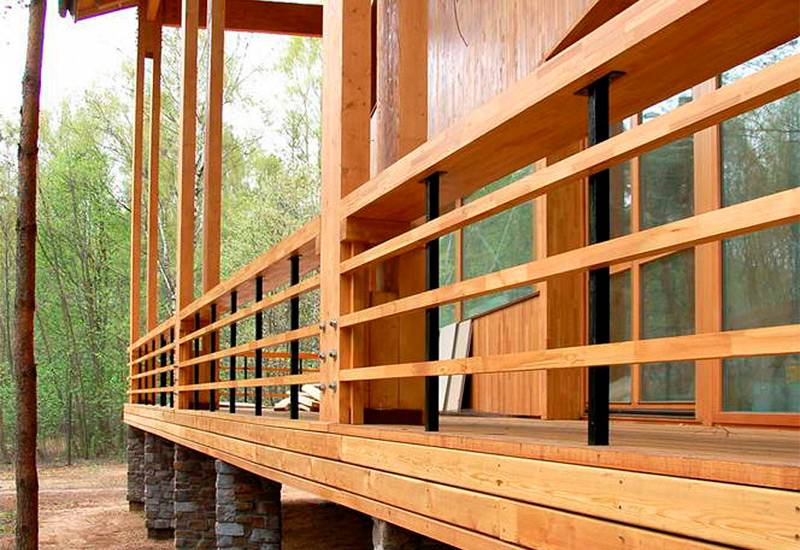
Classic
Classical fences include balusters in their design. The latter can have an elaborate rectangular shape, or they can be turned on a carpentry machine. In some cases, balusters are cut from planks and slats.
This design is popular in colonial and American architectural styles and is not used in the construction of modern cottages.
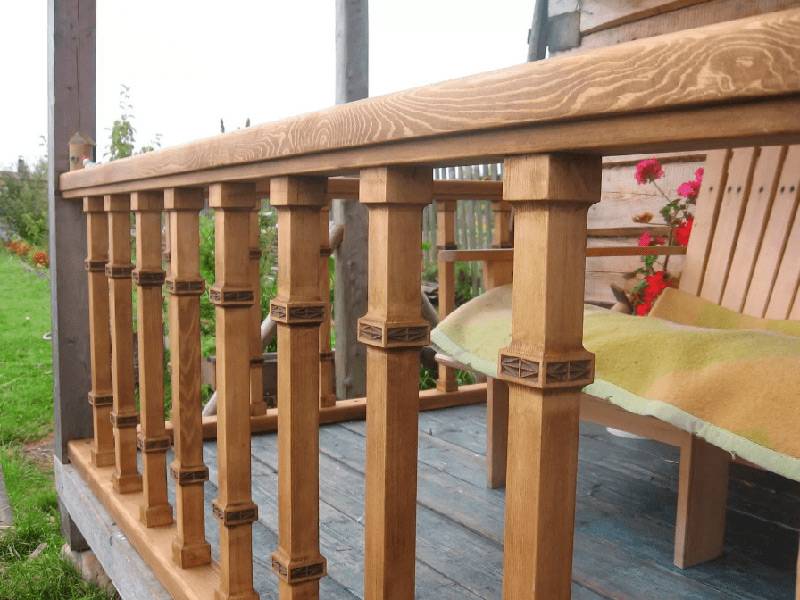
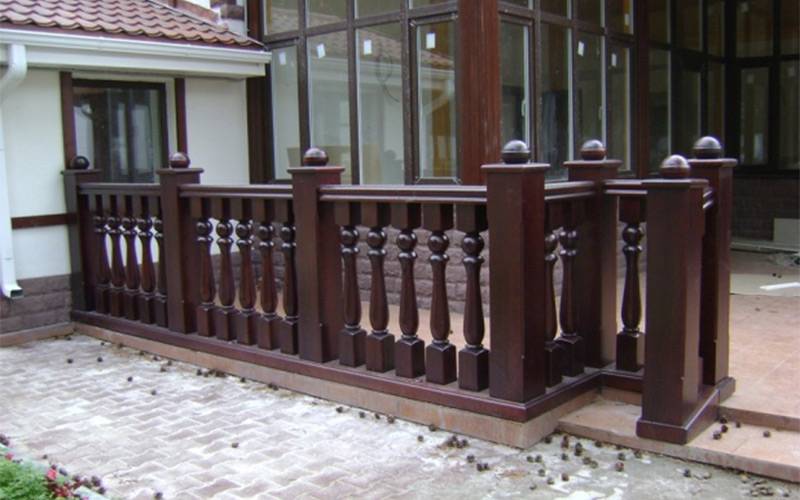

Net
In various rustic styles, the grid pattern of the fence is popular. It can be either oblique or orthodox, but in any case knocked out of rails, but not boards or, all the more, beams. It attracts the owners with its airiness.
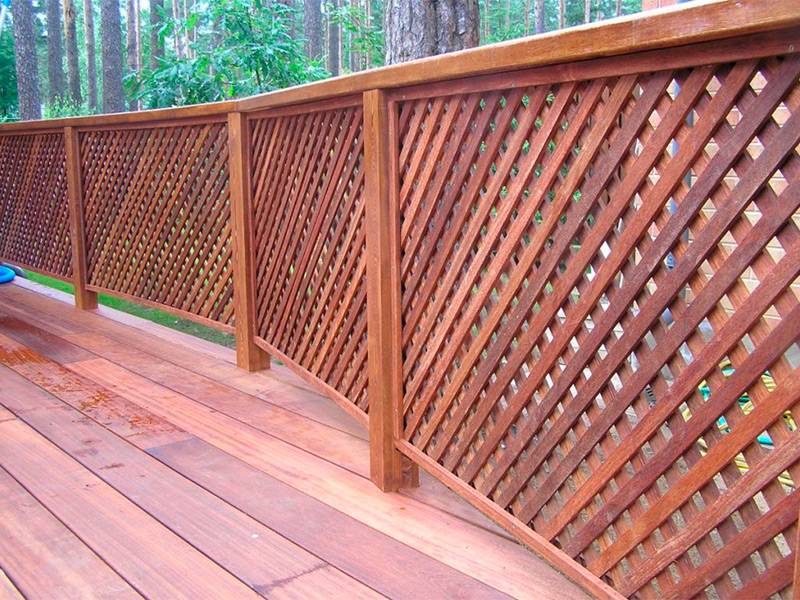
Log house
Lovers of log huts will appreciate the “Log house” style fence for the terrace. It is made of rounded logs according to the same principle as the whole house is being built. And it can be either monolithic or have decorative inserts that visually relieve the structure, making it not so massive. Based on the market value of the log, this is not the cheapest type of fence.

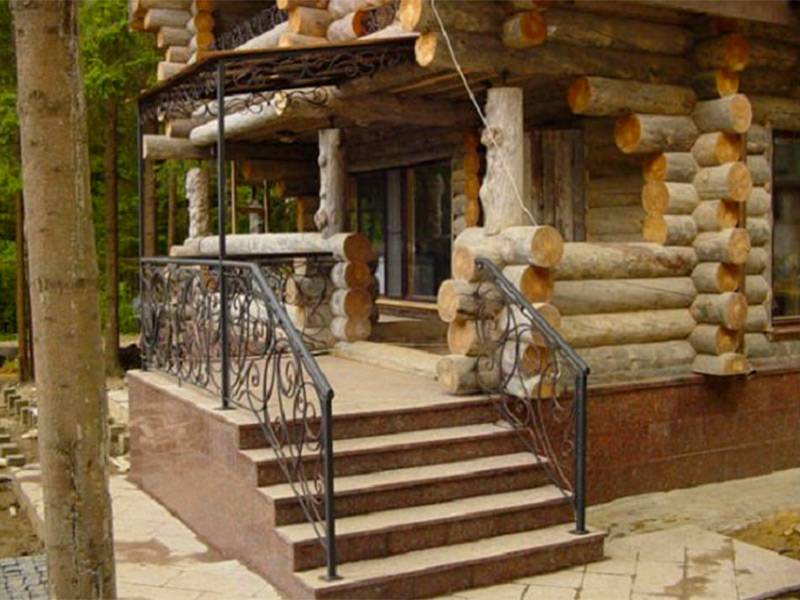
Wattle
If you are not attracted by the process of installing balusters on your terrace and generally reluctant to spend on a fence, you can weave a fence from a vine, as our ancestors did. Well, or follow the traditions of the Swiss, and build an alpine wicker from the boards. It looks very original.
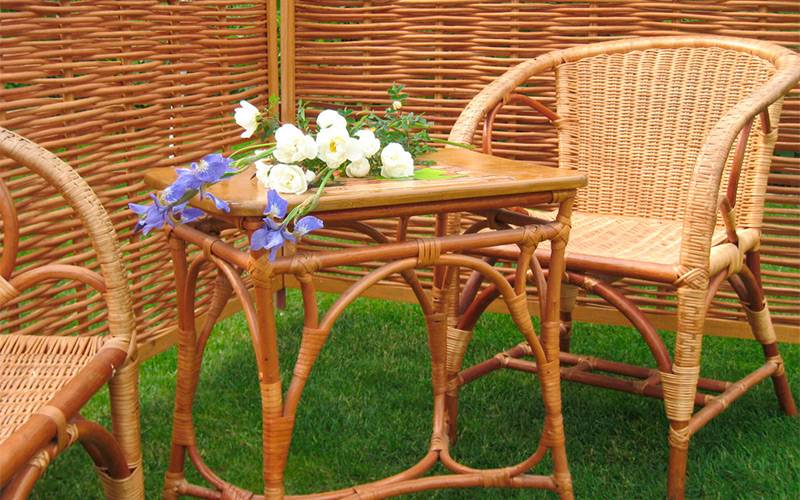
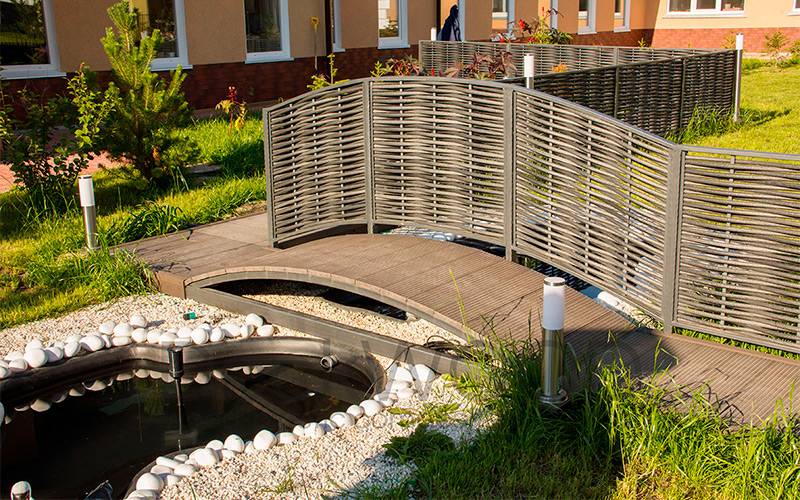
Palisade
It migrated to terrace construction from the Middle Ages and the palisade, only today it has only formal style features, which are expressed in vertically installed wooden elements, but instead of massive logs, modern designers use a deck board. And this is what the result of such creativity looks like in practice.
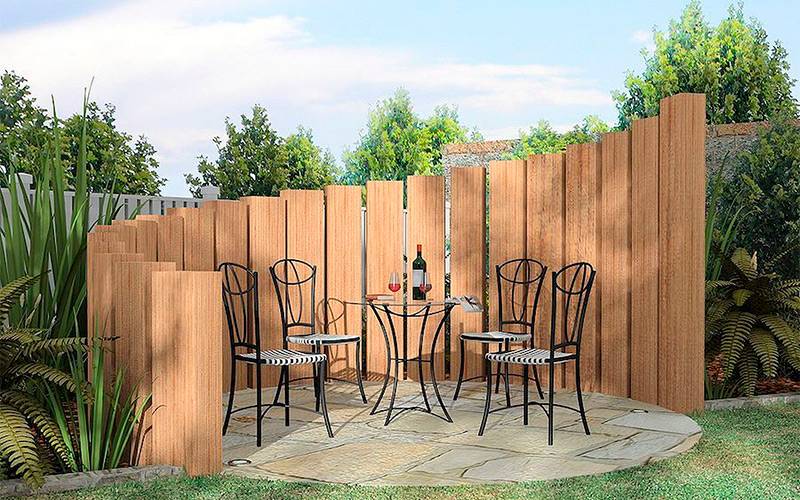
It is clear that the height of such railings on the terrace cannot be regulated by any norms or patterns.
In general, wooden terrace railings always look fresh and natural, but require constant and regular maintenance. Without varnishing and tinting, various oils and impregnations, the natural material quickly loses its appearance.
Important! The optimal location for a terrace in the middle latitude of Russia is in the southern direction.
What can be used to make a railing:
- Wood-polymer composite - WPC. White or brown, reminiscent of wood. It is durable, does not fade in the sun, does not dampen, and is not demanding to care for.
- Polyvinyl chloride - PVC. Cheap, lightweight, versatile. The downside is fragility.

- Wrought iron. It is important to calculate the weight of the structure. They can be combined with other types.
- Stone. Suitable for sturdy terraces, heavy.
- Wooden structures. A universal type with one drawback: it is demanding in care, subject to the influence of natural phenomena.
- Bamboo. This is the strongest and lightest option, it can convey the special imagination of the builder.
- Laminated and tempered glass. Ideal for maintaining a clear view of areas where dust and wind protection is required.
- Monolithic or cellular polycarbonate. The material is lightweight, inexpensive, transparent.
- Ropes and cables. They can also be made of stainless steel. They are pulled along the perimeter.
Did you know? It seems that linoleum is a thing from recent times. However, its prototype takes its roots from the 18th century and is associated with the name of Nathan Smith, who patented the oiled canvas.
Carpentry and construction experts recommend choosing the following breeds:
- larch (it has all the properties of hard rocks);
- ash (more susceptible to the influence of natural factors);
- thermally processed spruce;
- oak (which is quite expensive, but ideal as a material);
- bamboo (durable and beautiful).
One of the main stages in the assembly is the choice of wood. For street buildings, conifers, namely pine, are considered the best option. Wood is famous for its high content of resins, which protect the material from pests and prevent deformation from water or drying out.
Often, beech or oak is used for the production of wooden structures. However, the cost of such species is much higher than larch or pine.

Note! If you do not want to acquire a strong and beautiful railings without spending a lot of money - choose raw materials from larch. Larch is a very dense species, so it does not need additional processing.
Larch is a very dense species, so it does not need additional processing. The material is resistant to moisture and pests.
Terrace fencing options
 metal railings for the terrace
metal railings for the terrace
Wooden fences for the terrace are one of the most common and convenient to build. Since today “tree” is a very broad concept, the following can be distinguished for the construction of railings:
- wood-polymer composite;
- solid wood.
Curtains for the terrace in the country can also be used as a fence.
 WPC terrace fencing
WPC terrace fencing
On sale you can find a large number of different WPC materials with different textures and sizes. WPC finds its greatest application in the creation of floor coverings, but it is also excellent for handrails - it does not need to be painted and it does not require your care.
Beams and boards made of solid wood are the most ancient material for the manufacture of various buildings. Since wooden terrace fences are not exposed to a large amount of dirt and moisture, they retain their appearance for a long time and do not require special maintenance.
 Terrace staircase railing
Terrace staircase railing
Metal is great for creating railings. Today on the market you can buy both individual pipes and profiles, as well as purchase ready-made metal railings for the terrace. The most popular is the second option, since it provides a ready-to-use solution.
 Metal railing on the terrace
Metal railing on the terrace
From materials, preference can be given to both a tetrahedral metal profile and metal pipes. Unfortunately, both options require a welding machine and the ability to use it, but allow you to go beyond creative solutions.
Also, a ready-made option is forged fences for the terrace. Such a product is quite expensive, however, it is a real work of art. Forged railings are made both to order according to the developed drawings and sketches, and are sold ready-made, in the form of standard solutions.
If there is no welding machine and it is not possible to purchase it, you can use the options with fixing with corners using self-tapping screws or a nut connection, however, it has much less strength and security.
PVC railings
Plastic railing for a terrace is the cheapest, but not always unaesthetic material. There are many types of plastic on the market, but the most common is polyvinyl chloride.
 Plastic railing for the terrace
Plastic railing for the terrace
Plastic fences are sold:
- in the form of ready-to-install fences;
- separate materials.
It is not always easy to assemble the railings from individual PVC plates and poles - you will need a special soldering iron that solders the parts firmly. The material itself is easily sawn and cut with an ordinary knife, but for strong fences it is sometimes necessary to assemble a frame from metal rods.
The next step after laying the board on the floor is the construction of the fence of the open terrace. Fencing the terrace with your own hands can be done in different ways. In this case, everything is as simple as possible and no frills. The standard height of the guardrail is 90 - 100 cm. The main part of the guardrail is a board (for longitudinal bars, corner posts and wall mounts) and a bar (for cross bars), plus a board for the handrail of the fence.

It is more convenient to assemble the fence for the terrace on small trestles, but with small amounts of work, it can be mounted directly on the new floor of the terrace.
The order of installation of the fence, subject to accurate measurements and cuts, does not play a big role, but it is advisable to start with one of the side parts of the fence. To maintain the required level of inclination, use a building level, placing pieces of lumber under the fences.
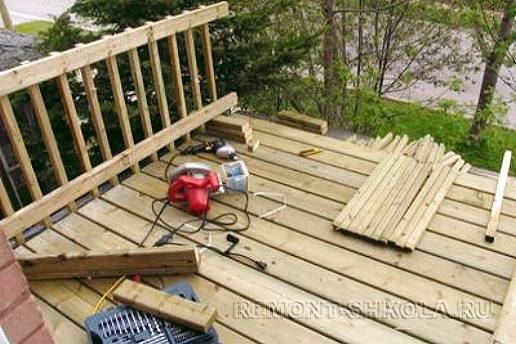
Installation of the terrace fence is carried out section by section, starting from one of the side elements.
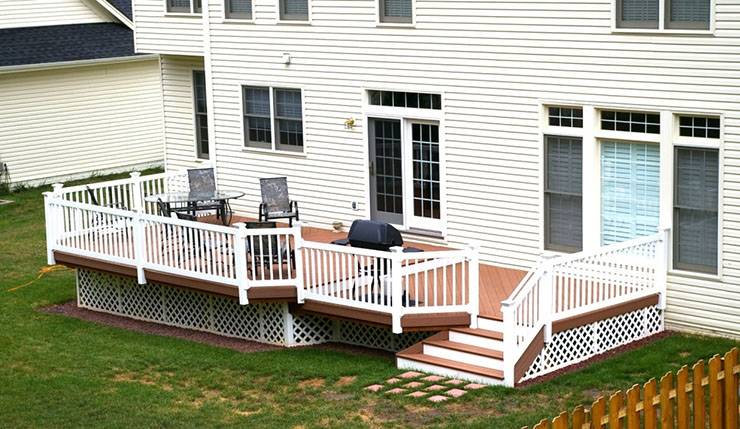

Mutual fastening of all three elements of the corner joint provides additional rigidity to the entire structure of the fence.
The corner posts in the lower part are fixed to the floor with metal corner-type fasteners. In the upper part, these racks are attached to the longitudinal elements using self-tapping screws, two self-tapping screws to each longitudinal board.
The uprights against the wall are attached to it with brick anchors. Enough for two for each post, but anything can happen, so it is better to play it safe and screw in three anchors for each post - top, bottom and middle.
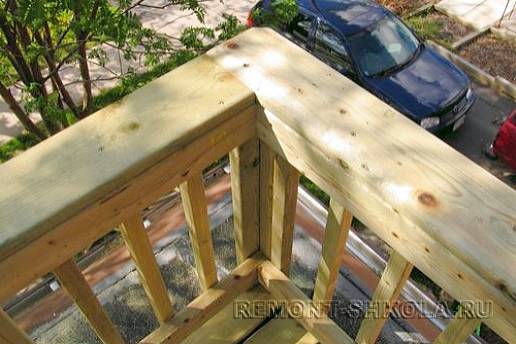
The width of the guardrail is determined individually. It is possible to install a handrail both along the inner or outer edge, and along the center line of the fence.
And the last thing to do is to install handrails on the terrace railing. Fastening the handrails is as simple as using wood screws.
The terrace railing is ready. All that remains is to bring out a couple of wicker chairs and a small table.
Handrail installation
The second is to hire a private craftsman who will grind the original posts, decorate any details for the railings with intricate carvings and assemble everything himself. You will be able to control the progress and quality of work, as well as gain useful information from communication with a specialist.

The third and most interesting thing is to make a reliable support for yourself and your loved ones. To do this, you must have at least a little woodworking skills. In addition to materials, you will need tools:
- Drill, a set of drills for wood;
- A machine for processing balusters (this is already a high level of skill);
- Screwdriver, jigsaw (for assembly);
- A set of cutters (if you plan and know how to cut wood);
- Chisel, hammer;
- Level for measuring the curvature of walls and other parts of the structure.
When the preparation is completed, they begin directly making the railing with their own hands.
- The height of the handrail for the stairs should be 90 - 100 cm, not less;
- The extreme points of support are under the greatest load. For this reason, they are made with a large cross section, reinforced for reliability. The thickness of the edge cabinet (or corner, holding the railing to the balcony) is made at least 100 * 100 mm .;
- The enclosing structure is necessary if the staircase to the terrace has 3 or more steps;
- Any railings or wall handrails must withstand a load of more than 100 kg / m;
- The handrails should be sanded, varnished, they should become even, smooth, without chipping and chips.
By following these simple rules, you will create not only an elegant decoration for your home, but a reliable structure that ensures the safety of you and your loved ones.
Metal terrace railings
Forged fences of terraces will remind us of the last building element, namely metal. Chains, rolling, cold and hot forging. This group contains designs for the most sophisticated taste and for any budget. Steel itself does not differ in high cost, but forged railings can compete in price with the best species of elite wood or stone and at the same time remain easy and undemanding to maintain.
The simplest and cheapest option would be to pull a chain as a fence, but an ordinary rope will be no less stylish. See how original and simple the designers have implemented this idea.
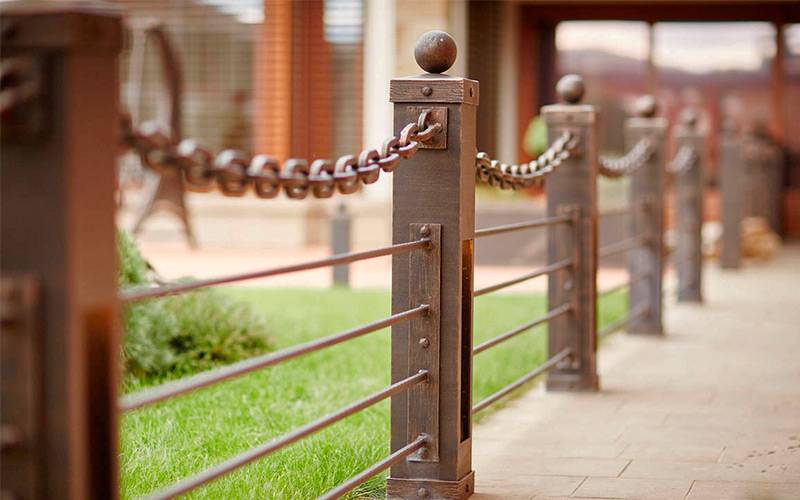
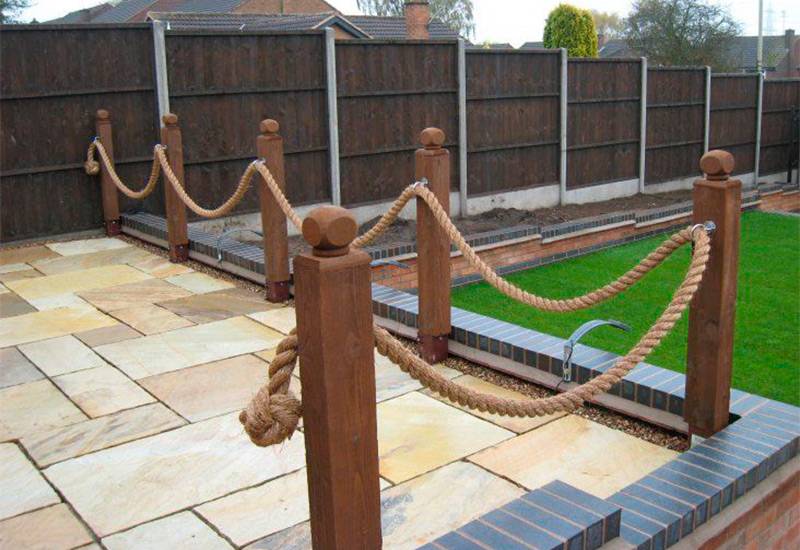
Forged railings will cost much more to the developer. More precisely, those where elements of cold forging were used: snails, baskets, torsion bars. In a word, those elements that were bent without a hammer and forge. Despite this unflattering description, cold-forged fences are pretty pretty. Especially if the master has worked on them.

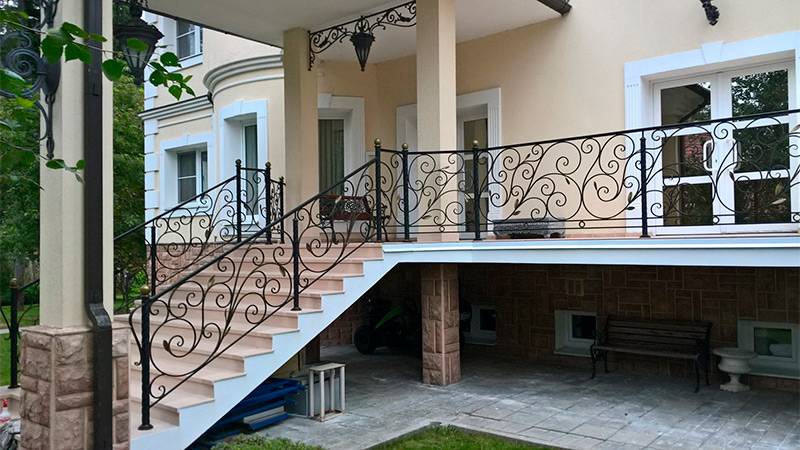
And finally, the premium class in this group will be art forging. Here the blacksmith creates beauty himself, not limiting his imagination to a set of well-known metal parts. He wants to forge a leaf, a bark-covered vine, or an intricate flower. And all this will be piece work that you will not find anywhere else.
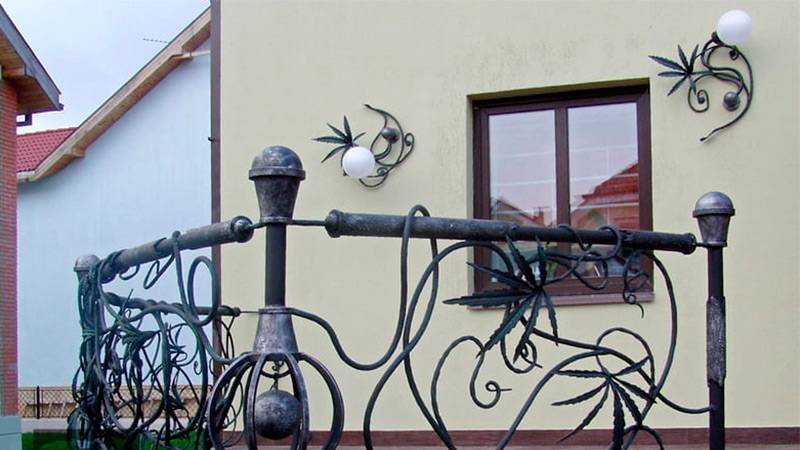
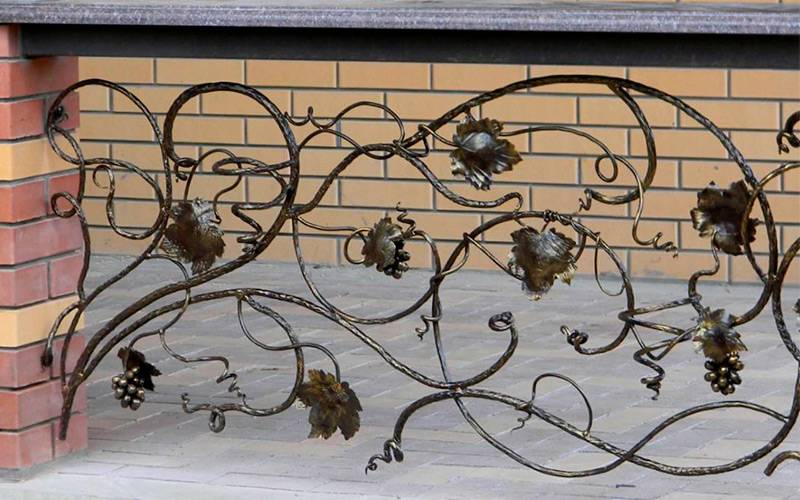
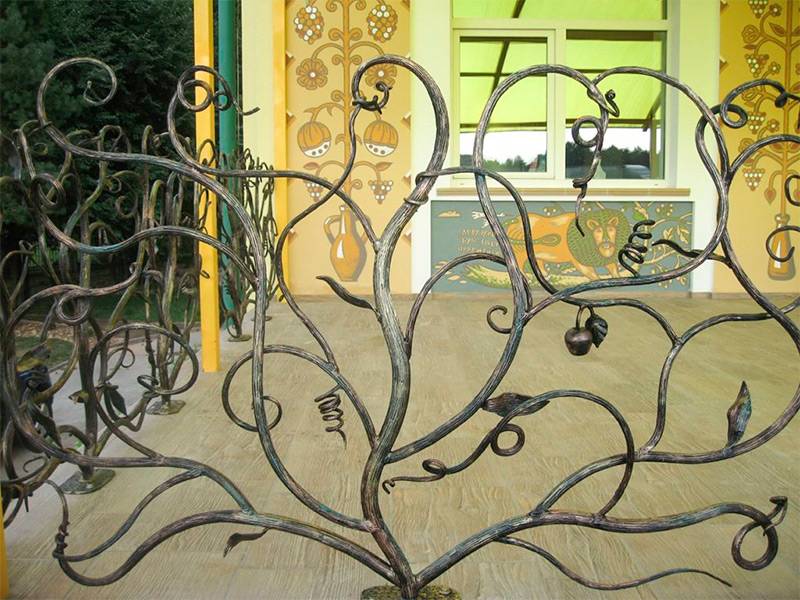
This is how it is, the fabulous world of terrace fences. What railings do you like? Or, perhaps, you have something to supplement this review, and would like to tell you more about some fences? Write, and we will definitely use your material in the next issues of our dacha blog. And on this goodbye and see you soon, friends.
Procedure for making a fence
When creating wooden railings for terraces, it is necessary to follow the technological process, which consists of three main stages:
- Design. The design of the fence can be ordered from a professional architect or done independently using 3D modeling programs. Based on the project, the calculation of materials is done. As a rule, the step of installing the supports of 120 cm is taken as a basis (this indicator may be lower if the balusters exert a greater load on the racks), the height is from 100 cm.
- Wood processing.
- Assembling the structure.
Working with wood
The complexity of the process of processing elements for terrace railings depends on the intricacy of the project. The easiest way is to make a handrail in the form of simple geometric shapes using ordinary wooden blocks. In this case, the processing consists of sawing and grinding. More complex details of the fence will require the use of a special tool - a jigsaw, a lathe, a cutter.
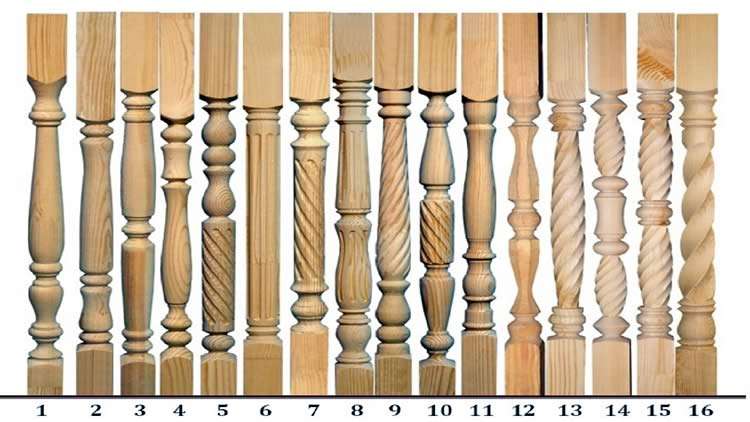
On the racks, spikes are harvested for fixing, and on the railing - grooves. The same nests are made at the ends of the support beams for attaching decorative elements.
Assembling the handrail
Installation of a fence made of wood is as follows:
- Supports are fixed on the terrace.
- Balusters are inserted into the prepared nests, the spikes of which are pre-lubricated with glue.
- Fix the railing of the fence.
- The structure is varnished or painted.
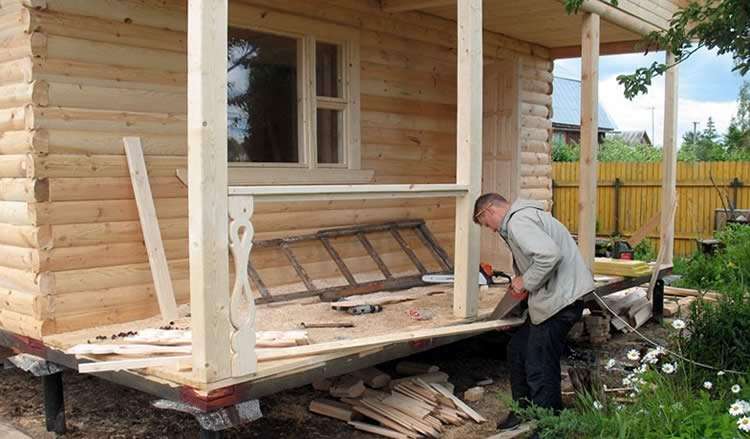
Even an inexperienced craftsman can make wooden fences for a terrace. If you have enough building skills, try creating a railing from concrete, brick, or natural stone.
DIY fencing
Using the example of a railing made of wooden elements, we will show how easy it is to make a fence to the terrace in the country with our own hands.
The railing begins only after finishing work with the floor. Let's say it will be a summer terrace with a simple fence around the perimeter. It is done with your own hands quite simply and in the following sequence:
- Mark on the floor where the supports will be installed.
- Prepare anchor holes for the supports.
- Install the supports using the threaded rod anchor.
- Place the columns for the railing at a distance of 1.5 m between the corner posts.
- Put the handrails prepared and processed from chipping and burrs on the support posts. Railings are often made from processed timber.
- Insert ready-made balusters below the lido railing and install a wooden trellis or planks.
- With the help of side elements, reinforce the fastening with brackets, you can also use pegs and struts.
- Fill the formed cracks with polyurethane foam and, cutting off its excess, seal up the foam areas with wooden panels or pieces of plastic of the same color.
- All wooden structures must be treated with an antiseptic compound, and all metal structures must be treated with paint or anti-corrosion liquid.
Your attached terrace has found a reliable fence, which you made at your own dacha with your own hands. If you decide that the summer terrace should be more closed, it is fashionable to install supports in the corners in the same way and build a roof structure or a simple canopy on them. The fence will remain the same. If you add wooden windows and doors to the railing, sew up the space with boards from below under the railing, then the terrace will become a closed veranda made by you in your favorite summer cottage.
What should be the railing
All architectural elements of houses are made in accordance with the requirements and regulations. This is not a whim, but a necessary measure. It is designed to protect the life and health of residents from accidental injuries and falls.
The terrace fencing is also made according to building codes that fully meet the accepted safety rules. Here they are:
- the total height of the railing should not be less than 50 cm;
- the minimum load that the structure must withstand is 100 kg per 1 sq. m;
- the minimum distance between the supports is 10 cm.
These requirements will allow both children and adults to be safely on the terrace near the house. Note that the higher the veranda is from the ground, the higher the pillars should be.
By type, terrace fencing is open and closed. The first option provides for the presence of free spaces between the vertical supports.
In the second, solid wood or metal shields are mounted between the posts. For summer cottages and country houses, in the overwhelming majority of cases, an open version is chosen. It allows you to effectively ventilate the veranda in the summer, making it more comfortable for the owners and guests of the house.
What are the features of making terrace railings?
Wood that is used for outdoor structures is usually made using a slightly different technology than for other purposes. First of all, a special brand of glue - D4 + is used for such wood. The same bonding agent is used in terrace constructions.
Scheme of varieties of wooden fences
There are also a number of other features that must be observed in the manufacture and processing of building material. And they are as follows:
- processing and grinding allows you to make the fence smooth, which will allow you to touch it freely;
- coating protection - some types of wood are very sensitive to external factors, and without a special coating they will quickly become unusable;
- the protective coating should not only fulfill its task (protect wood from rotting, delamination and destruction from temperature extremes), but also not be toxic, even though the veranda is outside.
Regarding the coverage, it is worth dwelling in more detail. If you order a ready-made fence, and not build with your own hands right on the terrace, then usually the manufacturer themselves process and impregnate the tree with all the necessary means. Well, for those who decided to do all the work on their own, it is worth knowing that modern varnishing can be water-based acrylic or solvent-based alkyd-urethane. There is not much difference in these funds, therefore they are both often used for terrace fences.
Fencing the terrace in the house should begin with the preparation of the project. You can do it yourself or order it from a professional designer. In addition, today there are many computer programs that allow you to see the "finished" form of the porch in ZD format. And this is very convenient, because right away, even at the preparatory stage, you can see all the strengths and weaknesses of the created fence.
Terrace fencing maintenance
The practice of caring for terrace fences depends on the material from which they are made. Wooden barriers, properly handled during construction, require almost no special maintenance. The impregnation protects the wood from premature aging, cracking and rot. If the barriers are closed, then wet wiping from time to time is sufficient to maintain them. External fences can deteriorate from moisture, wind and dust. In case of severe damage to individual sections, they can simply be replaced with new ones.
Metal fences require special care. Ferrous metal, as a material, always requires a special approach. It must be painted to avoid rust. During operation, the paint layer on such a surface should be constantly renewed. Steel fences, treated with special anti-corrosion compounds, serve for a long time and do not require separate maintenance.
Do you need a railing on the terrace?
The terrace itself is an open area located next to the house or separately from it. The fences on it perform both an aesthetic and protective function. They will not be justified on every terrace - for them there are a number of requirements that it is advisable to comply with.
First of all, the height affects the need for a fence on a veranda or terrace. Falling carelessly from a building can result in serious injury. If the terrace is located low enough, then you can do without fences.
In addition, the size of the terrace is an important factor. On a small building less than 4 sq.m. handrails will rather get in the way - they will cut an already small area, making use inconvenient.
Another factor is the durability of the foundation. If the construction is planned on a light foundation, then it will be impossible to erect brick or stone railings on it without additional reinforcement - they have a large mass and the foundation may not withstand.
In general, it is better to answer the question whether you need a fence for a terrace yourself - it depends on aesthetic preferences, the size and height of the structure. When planning, it is better to develop several projects of a terrace to the house with your own hands - a photo, which option is the best.
The choice of material for the construction of a terrace
Hardwoods that are resistant to abrasion and mechanical damage are best suited for building a terrace. These are oak and larch, and among exotic ones - tatachuba, lapacho, kumaru, ipa.
A material intended for an open terrace should also be slightly susceptible to changes in moisture, and in this respect, oak and larch wood is a good choice, and among exotic ones - teak and bankaray (balau). But the latter contains oils and tannins that can discolor or corrode adjacent materials.
But the most inexpensive and readily available natural material, which is most often used for terraces, is pine. When choosing pine, remember that this wood is quite sensitive to the cycles of moisture absorption and subsequent drying. Such an impact causes deformation and the formation of longitudinal cracks, therefore, before using pine boards and beams for building a terrace, it is necessary to thoroughly soak all the elements of the future terrace.
To implement the construction of a large expensive terrace, you can order a ready-made terrace system for specific dimensions. But if one of your goals is the minimum cost, purchase all the elements of the terrace yourself.
Railing for a terrace - what is the design feature and how to choose the right material for it?
The use of wood is associated with its availability, the relative cheapness of the material, the ability to make it yourself and the ease of installation.
For those who make a fence with their own hands for the first time, it is worth familiarizing yourself with the structure itself. And it consists of the following mandatory elements:
- supports;
- balusters;
- handrails.
But above all, the terrace itself must have a finished floor covering. After all, it so happens that they think about the railing right away, so until the floor is put in final order, work does not start with the railing.
As for materials, it is best to build such structures from wood. But you should only choose one that withstands all environmental influences well. The best options in this case are larch, oak, merbau or pine. But nevertheless, experts note that for our climatic conditions it is still good to stop your choice on Siberian larch. In addition, this breed has a number of other strengths:
Larch contains a natural antiseptic - resin. It is they who allow not to cover it with additional agents, including varnishes. Such naturalness already helps the tree to fight pests, fungus and even rotting.
The most commonly used fences are larch and pine.
If there is a desire to slightly "correct" the color of the fence, then for such purposes only stain or special tinting agents are used, not coloring agents. It is these methods that emphasize rather than obscure the natural structure of such wood.
The density of larch is 780kg / m3. These values are only slightly inferior to oak and beech, which means that such railings will last more than a dozen years, and their strength is quite reliable.
Despite the fact that larch is more expensive than pine (2 times), its cost is quite acceptable. But since such fences do not require any additional protective coatings, the difference can be reduced by up to half.
